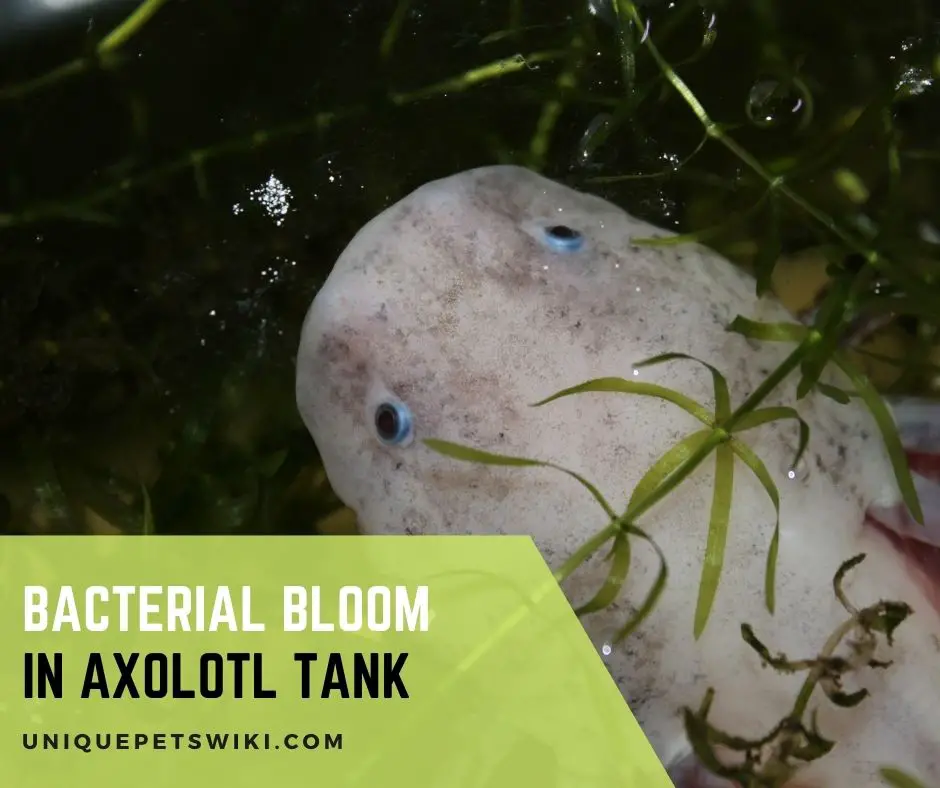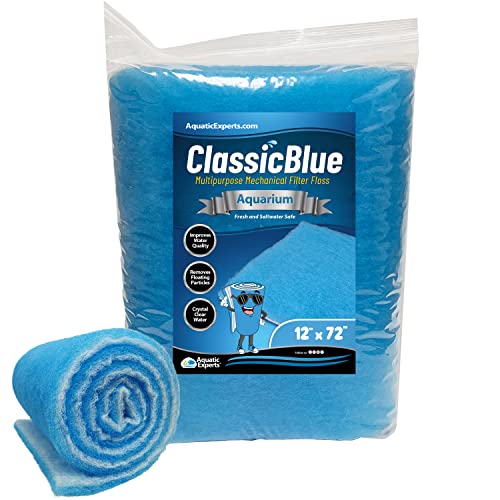The ideal aquarium for an axolotl and most aquarium owners is one with clean and clear water. However, you may experience a bacterial bloom in the axolotl tank at one point when keeping your axolotls.
Bacterial bloom, also called bacterial blossom, is a common occurrence where the water in your axolotl tank turns cloudy or milky.
Bacterial bloom can occur in an axolotl tank if there is an excess nutrient in the tank, there is excess sediment, the gravel is not cleaned properly, the filter is not working properly, etc.
As a responsible axolotl owner, it is best to know what bacterial bloom is, what causes it and how you can treat it. This article will help provide you with enough information you need about bacterial bloom in the axolotl tank.
Contents
Bacterial Bloom In Axolotl Tank
Bacteria bloom is a condition commonly found in a new aquarium but can occur in an established tank as well.
Bacteria bloom usually occurs due to initial bacteria growth, and it is not harmful to axolotl as it will clear on its own. However, you may need to consult with an expert if the bloom does not clear after 10 days.
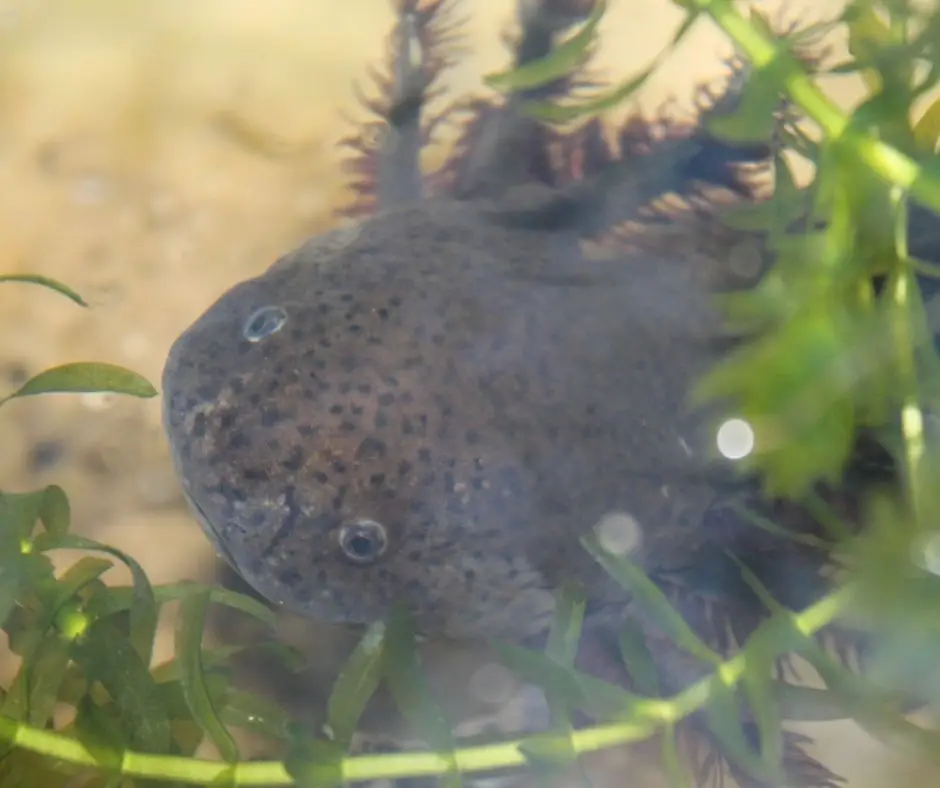
What is Bacterial Bloom?
Generally, there are two types of bacteria found in axolotl’s tank, which are heterotrophic and autotrophic. Heterotrophic bacteria feed on uneaten food, poop, dead plants & fish, and organic matter in the water.
On the other hand, autotrophic bacteria feed on toxic chemicals like nitrate, ammonia, nitrite, etc.
Bacterial bloom is a condition where there is a sudden increase in the number of bacteria suspended in the water column.
The increase in these bacteria makes it visible to the naked eye and will then affect the clarity of the water as the water becomes cloudy or milky in a few days.
Can a Bacterial Bloom Kill Axolotl?
No, the nature of most bacterial blooms is not usually to kill the axolotl. However, these bacteria will use lots of oxygen which can reduce the oxygen level in the water.
This can then cause oxygen deprivation which can be stressful to your axolotls.
You can then determine oxygen deprivation in axolotl if you notice that your lotls are gasping for air at the water’s surface.
It is recommended to increase the aeration in the tank to increase the oxygen content in the tank.
Why Is Bacterial Bloom In Axolotl Tank?
Generally, bacterial bloom usually occurs in a new aquarium, and this is because of the increase in the water nutrients, especially nitrates and phosphates.
It can also occur in an established tank if you are overfeeding your axolotl, dead fish or plant matter, excess waste in the tank, and so on.
Some of the reasons for bacterial bloom in axolotl tank are stated below:
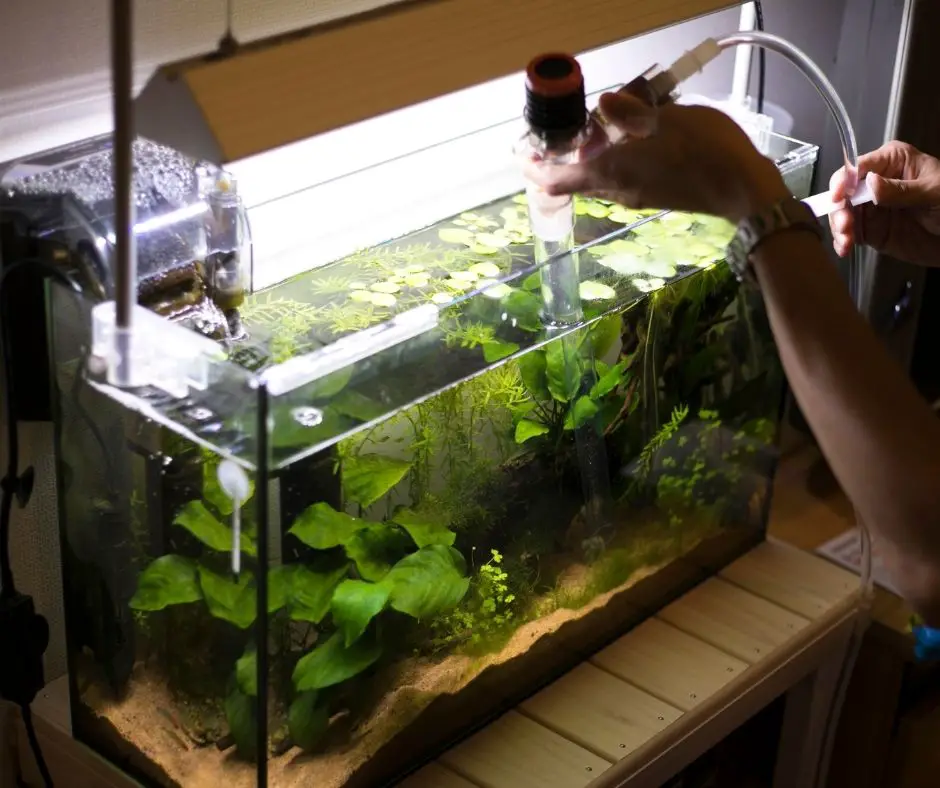
New Tank
It is common for bacterial bloom to occur if you are setting up a new aquarium during the early stage of the cycling process.
During cycling, there is a buildup of beneficial bacteria that helps to remove toxins like ammonia and nitrites from the axolotl’s tank.
You can determine there is a bacterial bloom in a new tank if you notice white or grey cloudy water in the tank after 3-5 days of setting up the new tank.
The bacterial bloom in the new tank is not harmful to your fish and may go away after 1-2 days.
The best thing to do if you notice this is to leave the tank for 1-2 days for the bacteria to settle while the water clears up if you have introduced the fish.
However, you may need to change the water or increase the air supply if you notice that the fish is gasping for air at the water surface.
You may then need about 3 weeks for the tank cycling process to complete if you have not introduced the fish.
Sudden Increase in Nutrient Levels
Bacterial bloom can occur in the axolotl tank if there are ammonia and nitrite spikes in the tank. Nutrient spikes can occur if you overcrowd a tank, overfeed your axolotl, or just finish cycling the tank.
The bacteria will then multiply rapidly to remove the additional organic waste produced, making the tank cloudy.
A great way to deal with this is to ensure you don’t overcrowd your axolotl tank. This will help ensure the axolotls do not produce lots of waste, causing nutrient spikes.
You should also avoid overfeeding your axolotl and try to remove leftover food immediately.
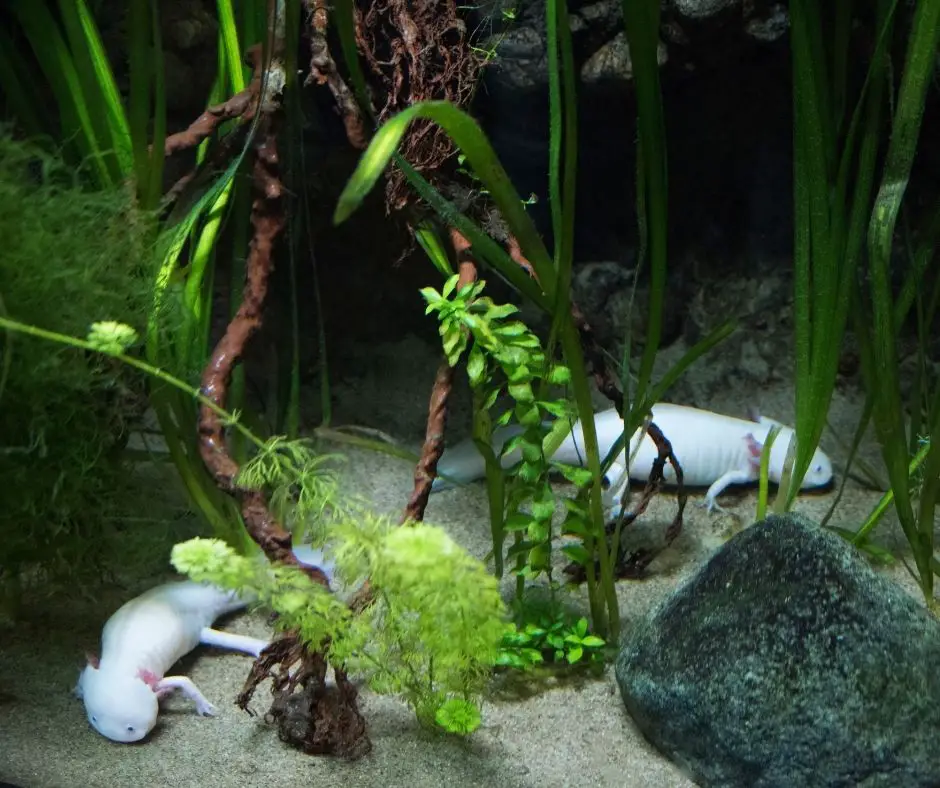
Restart of Beneficial Bacteria
It is possible for the beneficial bacteria in an axolotl tank to be wiped out if you add medications or use untreated source water to a tank.
The beneficial bacteria colony will then try to rebuild itself, causing bacterial bloom.
This is a common situation that can occur after 2-3 days of using medication or chemicals in an axolotl tank.
You can prevent this by ensuring you use a water conditioner during a water change. It is also recommended that you use existing tank water for washing or rinsing filter mediums and ornaments.
This will help to prevent you from unsettling the beneficial bacteria colony.
Restart of Filtration System
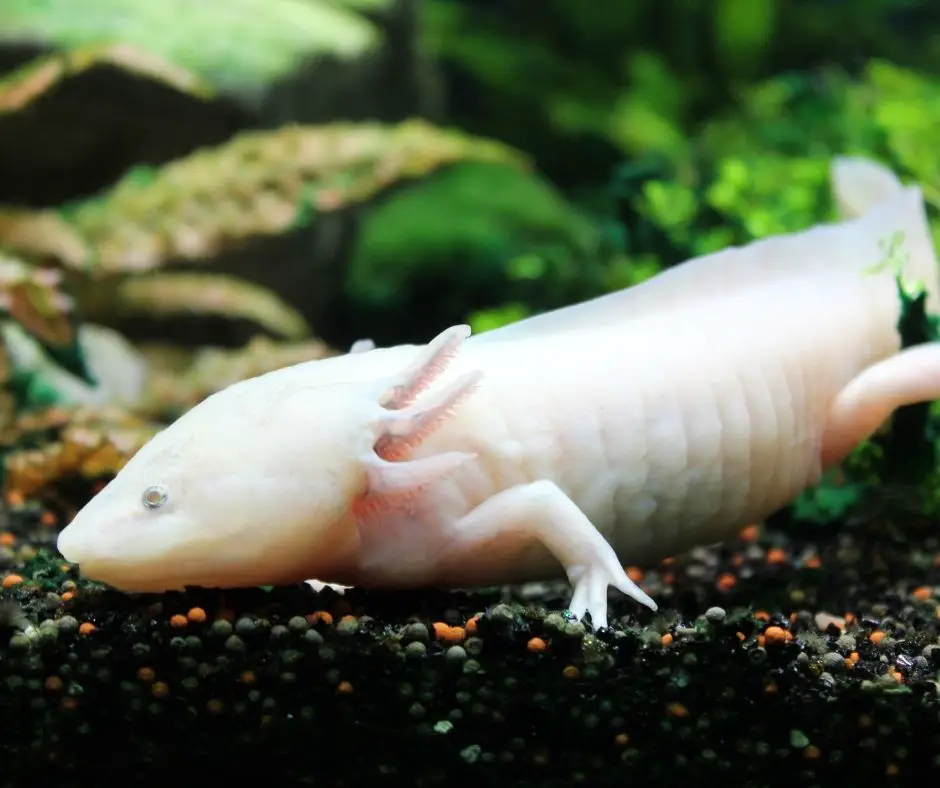
It is also common for bacteria to bloom if you are just restarting the filtration system after a long shutdown or replacing the established filter with new ones.
This is because lack of water movement will cause the oxygen to deplete, causing the beneficial bacteria to die off.
Turning on the filtration system will then lead to the bloom of the beneficial bacteria.
You can easily prevent this by ensuring you don’t turn off the filtration system.
When changing the filter medium, it is recommended that you mix 50% of the new filter medium with an established filter to help accelerate the cycling process.
Aquatic Experts Classic Bonded Aquarium Filter Pad
- POPULAR CHOICE - Our Classic blue and white bonded filter pad is a popular multipurpose filter media perfect for freshwater or saltwater aquariums. The filter pads' resilient fibers trap floating debris to help KEEP YOUR AQUARIUM WATER CRYSTAL CLEAR; the open fiber construction promotes water flow and prevents premature clogging.
- CUT TO FIT - Made in the USA! Our ClassicBlue aquarium filter pads can easily be cut to fit most filters and WILL SAVE YOU EVEN MORE MONEY over purchasing ready-made pre-cut filter material. Our poly filter pad is PERFECT FOR FRESHWATER OR SALTWATER aquariums as a prefilter for wet/dry filters, sumps, canister filters, aquaponics system, and much more. You will receive one 12 inch by 72 inch by 3/4 inch thick filter pad.
- HIGH QUALITY AND DURABLE - Our aquarium filter floss is CONSTRUCTED OF DURABLE POLYESTER FIBERS bonded by our special resin which gives the media the STRENGTH TO LAST TWICE AS LONG as the rest. Blue pigment is added to our POLY FILTER PAD to holdfast resin to keep the color on the pad and out of your aquarium water longer than other filter media pads.
- IMPROVE WATER QUALITY- Place our filter floss aquarium pad in flowing water to trap uneaten food, waste, decaying plants, detritus, and other coarse to small floating particulates from the water. Changing filter media regularly will INCREASE WATER QUALITY BY REMOVING SOLID ORGANIC COMPOUNDS before they continue to break down and add additional nutrients to the water in your fish tank.
- SAVE MONEY - Use this in place of expensive filter pad. Combine with our high quality activated carbon to do everything a branded filter pad can do for much less!
Last update on 2022-12-29 / Affiliate links / Images from Amazon Product Advertising API
How Do You Get Rid Of A Bacterial Bloom In Axolotl Tank
A good thing about bacterial bloom in an axolotl tank is that you can easily control them. Normally, you don’t really have to do anything as it will go by itself in a couple of days.
However, you may need to get rid of bacteria blooming if the water does not clear after 1-3 days.
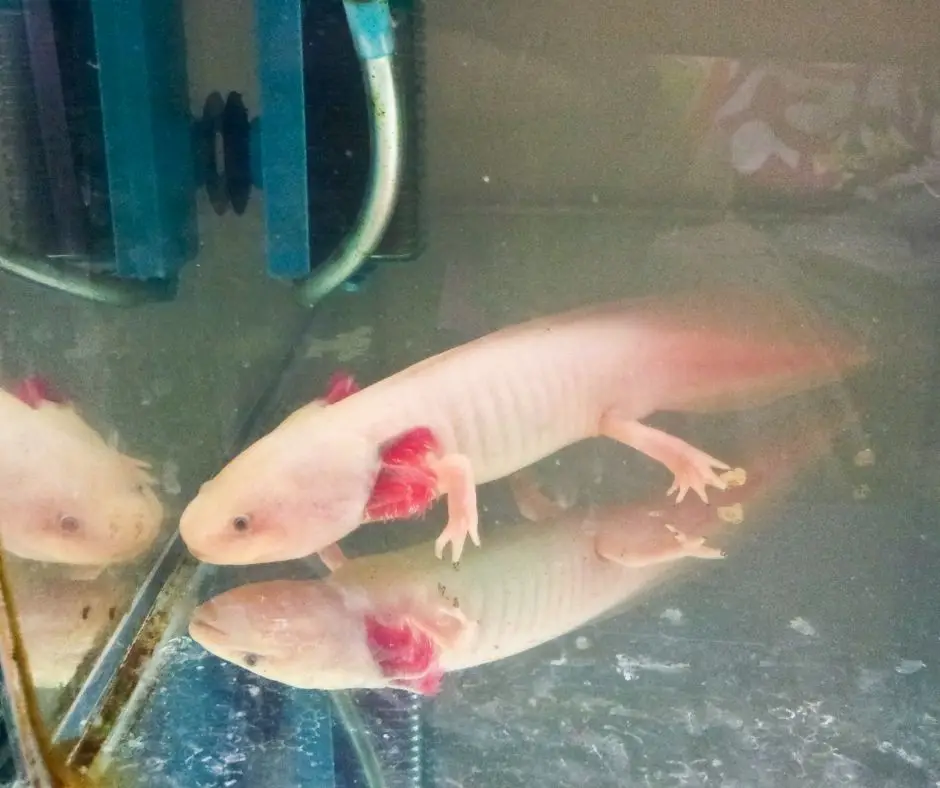
Some of the ways that you can get rid of bacterial bloom in axolotl tank are stated below:
- Remove the excess toxins like ammonia causing the bacterial bloom.
- Remove leftover food, dead fish, snails, or aquarium plants from the tank.
- Remove or detoxify your axolotl waste to ensure no chemical buildup.
- Add activated carbon media to the filter to help clear the water and absorb the nutrients that can cause a bacterial bloom.
- Do 50% water change and use Seachem prime or stability for 3-5 days.
OXO Good Grips Baster with Cleaning Brush – Black
- Unique bulb shape and collar for two comfortable grip options
- Flat bulb prevents rolling
- Crack resistant, high heat plastic
- Easy to read standard and metric measurement markings
- Top-rack dishwasher safe
Last update on 2022-12-29 / Affiliate links / Images from Amazon Product Advertising API
Seachem Prime
Seachem Prime is a great way to ensure there is no bacterial bloom in your axolotl tank.
The conditioner helps to treat tap water and will help to convert toxins like ammonia and nitrites in the water to a non-toxic form that beneficial bacteria can digest.
You can use a Seachem Prime for your axolotl tank by following the steps below:
Use one capful of Seachem Prime for every 50 gallons of water in the aquarium every 48 hours.
However, you will need to add a high concentration of Seachem prime in extreme situations. You can add 5x Seachem Prime. For instance, you can add 5 capfuls of Seachem Prime for a 50-gallon tank.
You will notice that the chemical buildup starts to reduce, and the water becomes clear.
Seachem Prime Fresh and Saltwater Conditioner
- POWERFUL TREATMENT: Seachem Prime is a complete and concentrated conditioner for both freshwater and saltwater fish tanks, working hard to remove chlorine and chloramine.
- REMOVER: Seachem Prime immediately and permanently removes chlorine and chloramine, successfully allowing the bio filter to remove ammonia, nitrite, and nitrate while they are detoxified for 48 hours.
- DETOXIFIER: Seachem Prime effectively detoxifies ammonia, nitrite, and heavy metals found in the tap water at typical concentration levels, providing a ideal environment for your betta, tetra, or other fish.
- USE: Use 1 capful (5 mL) of Seachem Prime for each 200 L (50 US gallons) of new or replacement water. For best results, add Seachem Prime to new water first. For exceptionally high chloramine concentrations, a double dose may be used safely. For smaller volumes, use 2 drops per gallon.
- SAFETY: In case of an emergency, the 5x dose of Seachem Prime may be used for both ammonia and nitrite. Use a ½ dose if the water temperature is > 30°C (86°F) and chlorine or ammonia levels are low.
Last update on 2022-12-30 / Affiliate links / Images from Amazon Product Advertising API
Seachem Stability
You can also use Seachem Stability to treat bacterial bloom in an axolotl tank. The good thing is that Seachem stability will also help remove excess waste from the tank.
You can follow these steps when using Seachem stability:
- Turn off the UV/ozone
- Use a capful of seachem stability for every 10 gallons of water for seven days.
- Spot clean the tank regularly to help ensure there is no waste and food in the tank.
- Redose the tank again after 48 hours if there is ammonia and nitrite content in the water.
Seachem Stability Fish Tank Stabilizer
- TANK STABILIZATION: Seachem Stability will rapidly and safely establish the aquarium biofilter in freshwater and marine systems, thereby preventing the #1 cause of fish death: "new tank syndrome".
- TREATMENT: Stability is formulated specifically for the aquarium and contains a synergistic blend of aerobic, anaerobic, and facultative bacteria which facilitate the breakdown of waste organics, ammonia, nitrite, and nitrate.
- BACTERIA GROWTH: The necessary conditions for the growth of Stability's bacteria strains encompass a very broad range. When other bacteria begin to die off (usually from high organic loads caused by the unknown death of an organism), Stability simply becomes more effective.
- USE: Shake Seachem Stability well before use and turn off UV/ozone filter. Use 1 capful (5 mL) for each 40 L (10 US gallons) on the first day with a new aquarium. Then use 1 capful for each 80 L (20 US gallons) daily for 7 days. Fish and other aquatic species may be introduced at any time as long as dosage is maintained for 7 days.
- SAFE: The bacteria employed by Stability are non-sulfur fixing and will not produce toxic hydrogen sulfide. Stability is completely harmless to all aquatic organisms as well as aquatic plants, thus there is no danger of overuse.
Last update on 2022-12-29 / Affiliate links / Images from Amazon Product Advertising API
How To Prevent Bacterial Bloom in Axolotl Tank
As stated before, bacterial bloom is usually a common sign found in a new tank.
The good thing is that bacterial bloom is not harmful to axolotls and can easily be prevented. Some of the ways that you can prevent bacterial bloom in axolotl tank are stated below:
- By using a strong filter
- By ensuring your axolotl tank is big enough and not overcrowded.
- Do partial water changes regularly and maintain the tank to reduce the buildup of nutrients.
- By removing the source of nutrients like excess food or decaying matter from the tank.
- Avoid overfeeding your axolotls.
- Providing good quality food in an ideal amount to help ensure there is no leftover food.
FAQs
Should I do water changes during a bacterial bloom?
No, you don’t have to do a water change during a bacterial bloom. You will just add to how fast the bacteria grow by doing this.
All you have to do is leave the water, which will become clear after some days.
How long does a bacterial bloom last in an aquarium?
Generally, bacterial bloom usually occurs between 2-4 days. However, you may need to consult your aquarium specialist if the water does not clear after 10 days.
How do I clear my cloudy axolotl tank?
The best way to treat a cloudy axolotl tank depends on the cause of the bacterial bloom.
However, some of the ways that you can clear a cloudy axolotl tank are stated below:
– Use a bigger tank to prevent overcrowding
– Use a good quality filtration system.
– Spot clean the tank regularly.
– Do partial water change regularly.
Can a Bacterial Bloom Kill or Harm Your Fish?
No, bacterial bloom cannot directly kill your fish. However, it can indirectly harm or kill your fish.
This is because bacteria in the bloom are aerobic and use the oxygen in the tank to flourish and survive.
This can then lead to a drop in the oxygen level in the tank and can affect the health of your fish.
The level of fatality that a bacterial bloom can cause will be determined by how big the bacterial bloom is.
Can you add fish during a bacterial bloom?
You can add fish to your tank during a bacterial bloom if the ammonia and nitrite levels in the tank are at zero.
You can even introduce algae-eating fish like snails and other scavengers to the tank to eat up the algae.
How long do beneficial bacteria take to grow?
Generally, it usually takes about 4-6 weeks for beneficial bacteria to grow in a tank while cycling a new aquarium.
Wrapping Up
As you can see, the bacterial bloom is something you will surely encounter as an aquarist.
It is usually common in a new tank but can also be found in an established tank with leftover food, excess waste, dead plants, faulty filter, and so on.
The good thing is that bacterial bloom does not harm axolotls directly, and it clears after a few days.
We hope this article provides you with everything you need about bacterial bloom in an axolotl tank. You can message us below if you have any question or comment on bacterial bloom in the axolotl tank.
